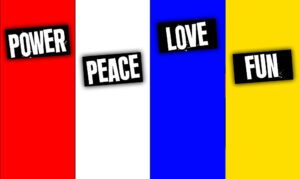
What are the Color Code Personality Types?
Dr. Taylor Hartman created The Color Code Personality Type, or The People Code, which classifies Personality Types by Core Motives.
It helps you understand an individual’s motives and the “Why people do what they do” to gain insight into people’s behavior and build more effective relationships with the people you interact with regularly.
The Color Code Personality Types help you recognize your innate strengths and limitations and show you how to use those traits in your personal and professional life.
Generally, Reds comprise 25% of the population, Blues 35%, Whites 20%, and Yellows 20%.
The Color Code Personality Type system is similar to the Four Core Personality Temperaments. Still, it focuses more on how people interact with others and less on personality tendencies like introversion vs. extraversion.
Personality Temperament, Traits, and Type
Personality Temperaments, Personality Traits, and Personality Types are used in Psychology to discuss a person’s Personality, a collection of Emotions, Perceptions, and Actions that interact with each other, regulate themselves, and shape a dynamic system that forms a person’s Behavioral Patterns.
Your inherited traits (your personality Temperance) and acquired traits (such as education, socialization, and other various pressures and aspects) form your Personality.
A Personality Type identifies a specific collection of Traits, both learned and natural, that comprise a broad, general Personality Classification—a way of labeling a collection of traits and behaviors.
A Personality Trait remains consistent and stable over time, which means you exhibit the same pattern across different situations and throughout your life.
Three criteria characterize Personality Traits: (1) consistency, (2) stability, and (3) individual differences. For example, if you are talkative at home, you also tend to be talkative at work. And if you were talkative at age 20, you would still be chatty at age 40.
Personality Temperament is your “Naturally Intuitive” biological Trait. These Traits are partly inherited from your genes and partially determined by your brainstem, which doesn’t change throughout your life. These are Natural Traits regarded as innate or inborn and not learned.
Your Personality Temperament is formed as an infant and is hard to modify, manipulate, or change because it is genetic. In some way or another, your inherited behavioral tendency will always be there.
Personality Traits are quantitative differences between people, and Personality Types are qualitative differences between people. The most crucial difference between the Trait Theory and the Type Theory is that the Type Theory views people’s characteristics as discrete categories. In contrast, the Trait Theory views these characteristics as a continuum.
For example, while a Type Theorist would claim that introverts and extraverts are two types of people, a Trait Theorist claims that extraversion is a gradient, and individuals can fall somewhere in the middle.
Your Temperaments, along with acquired Traits, form your Personality.
Red Color Code Personality Type

The Red Personality Type is hungry for power and wants their way.
If they were raised in environments where they could manipulate their parents and siblings, they become difficult to manage as they age.
When they have gotten their way for too long, they find it almost impossible to relinquish their power and freedom when they meet societal authorities (teachers, bosses, police, clergy, military officers) who refuse to grant them the total control they demand.
Red-type people want to be productive.
Reds like to work at everything—in school, their careers, and their relationships.
Don’t expect them to attach the same importance to things as you, but give them good reasons and watch them take off.
Reds like to get the job done and are often workaholics. But they will resist being forced to do anything that doesn’t interest them.
Red-type people want to look good to others.
Reds need to appear knowledgeable and crave approval from others for their intelligence and insight.
They want to be respected even more than they want to be loved. Reds want to be admired for their logical, practical minds.
When you deal with a Red, be precise and factual. Reds are unmoved by tears and other displays of “weakness.”
Don’t take Red Type people too seriously.
Despite their antagonistic demeanor, Reds often state the facts as they see them and seldom say “in my opinion” before expressing their opinions.
Reds enjoy a good power play. However, once you get emotionally involved in arguing issues, you may find that a Red is no longer interested and is only curious about debating.
Red-type people seek leadership opportunities.
Despite the rigidity of the military, many young Red people enter it as a career to experience leadership.
Reds like to be in the driver’s seat and are often called “Control Freaks.”
Red-type children are often frustrated in school because teachers (usually Blue personalities) won’t let them take charge.
Reds are willing to pay any price for an opportunity to lead.
Learn more about the Red Color Code Personality Type.
Blue Color Code Personality Type

The Blue Personality Type is motivated by altruism and love to do nice things for others.
They look for opportunities to give up something to bring another person happiness.
Selflessness rather than selfishness is their guiding philosophy.
Many Blues are uncomfortable doing things solely for themselves.
They hold doors open for people, offer rides when someone’s car breaks down, contribute to charities, and even devote their entire lives to helping others.
Blue-type people seek intimacy.
More than anything else, Blues want to love and be loved. A true Blue will sacrifice a successful career to improve a meaningful relationship.
Blue-type people crave being understood.
Blues are gratified when they are listened to and feel understood and appreciated.
They are notorious for revealing their inadequacies because they greatly value being known and understood.
In Blue’s eyes, vulnerability is a small price to pay for the chance to connect emotionally.
Blues may have their hearts broken more than most people, but they also spend much more time in love.
Blue-type people need to be remembered and appreciated.
With Blues, a simple pat on the back will not suffice. They expend such great effort in making the world a better place that sometimes they need to be told how wonderful they are. They need to be thanked and remembered explicitly for their good deeds.
Blues delight in being remembered on birthdays and other special days, especially if the remembrance is personal—a homemade anniversary card, a welcome home party, or a special day that isn’t on the calendar.
Blues need tender, loving care.
A solid moral conscience directs Blue Types.
Blues are motivated to behave in a proper, appropriate manner.
They have a moral code guiding their decision-making, value judgments, and leisure time. As a result, Blues enjoy being “Good.”
Blues come equipped with the most vital sense of integrity of all the personality colors.
Blues are trustworthy and would rather lose than cheat. Ethically, Blues are the people who should be in positions of power but seldom are.
Learn more about the Blue Color Code Personality Type.
White Color Code Personality Type

White Personality Types are motivated by peace and will do almost anything to avoid confrontation.
They like to flow through life without hassle or discomfort. To Whites, feeling good is even more important than being good.
White-type people need kindness.
While Whites respond beautifully to thoughtfulness and amiability, they have a robust, silent stubbornness that surfaces when treated unkindly.
They resent being scolded, and they dislike harsh words.
Whites open up instantly to people who are kind and recoil from those who are hostile. They are motivated by kindness—and can’t understand why other people are unkind.
White-type people prefer quiet strength.
Whites enjoy their peaceful independence.
Those who misinterpret the peace-loving nature of a White as an invitation to be demanding and bossy will soon meet a wall of passive resistance.
White-type people like to keep a low profile.
Whites want to be asked their opinions and won’t volunteer them.
They value the respect of others, but they rarely go out of their way to seek it.
Whites must be coaxed to discuss their skills, hobbies, and interests.
White-type people are independent.
Unlike Reds and Blues, who want to control others, Whites only seek to avoid arrest.
They refuse to be under another’s thumb, especially when treated without the respect they deserve.
Whites want to do things their way, in their own time.
They don’t ask much of others and resent it when others demand things from them. However, Whites will comply with unreasonable demands—to keep the peace.
They will only express their anger and frustration when they can no longer be bossed around. Whites don’t like to be pushed, and they can be fearsome when they finally “blow up.”
White-type people are motivated by other people’s desires.
Whites are open to others’ recommendations on resolving any situation; however, they want suggestions—not demands.
Learn more about the White Color Code Personality Type.
Yellow Color Code Personality Type

The Yellow Personality Type values play, wants to have fun, and is often considered the life of the party.
Yellow-type people welcome praise.
Yellows need to be noticed. Little else improves a relationship with a Yellow more than praise.
Yellows need to know they are valued and approved of.
They often act like they have the world by the tail, but they have their fears and frustrations—which they rarely confide in until they know they are emotionally safe.
Safety is most effectively evidenced to Yellows through praise.
White-type people need emotional connections.
Yellows often appear so calm that people think they don’t care about anything. Nothing could be further from the truth. Yellows need a great deal of attention.
To them, physical contact is often the most direct, comfortable, intimate connection.
White-type people want to be recognized.
Yellows like to be center stage. Social acceptance is critical to them.
Friendships command a high priority in their lives because popularity answers one of their essential needs—the need for general approval.
Yellows are highly verbal. They relish good conversation and can superficially chitchat with the best of them.
White-type people like action.
Yellows can quickly get bored and seek adventure.
Unfortunately, many people are misdiagnosed as having ADD (Attention Deficit Disorder) when, in fact, they are merely Yellow personalities struggling with their innate inability to sit still for very long and stay focused.

